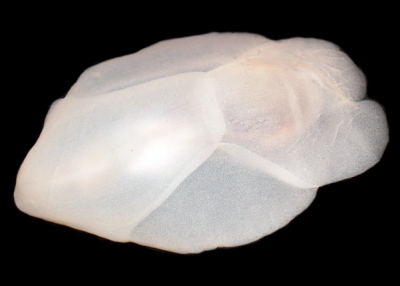Philine angasi from sthn Queensland
November 17, 2008
From: Gary Cobb

Concerning message #176:
Hi Bill and everyone!
David and I had another great day at Moreton Island. We added another species to our ever growing list ... 354. After a 2 hour dive at the north west side of Flinders reef we drove 'Mischief ' over to the west side of Moreton Island to anchor and have lunch. A friend of mine and I swam over the island and back to the boat. While swimming I noticed the small sea grass patches. Blade lengths were about 100 mm and sand bottom. I decided I should have a better look and got into my gear and went to the bottom which was 8 feet down.
Upon reaching the grass I noticed lots of egg masses on stalks! Just like the egg mass photo on the Philine aperta page. I then proceeded to 'rake' the bottom to see what would happen and then a large white slug appeared!! I then swam around and raked more areas and found dozens of animals.
Richard Willan tells me this species lives it's entire life under the sand eating small crustaceans, only sufacing to spawn.
Locality: Moreton Island, 3 m, Queensland, Australia, Pacific Ocean, 15 November 2008, Subtidal. Length: 13-42 mm. Photographer: Gary Cobb.
Cheers
Gary
gary@nudibranch.com.au
Cobb, G.C., 2008 (Nov 17) Philine angasi from sthn Queensland. [Message in] Sea Slug Forum. Australian Museum, Sydney. Available from http://www.seaslugforum.net/find/22053
Dear Gary,
Thanks for the record. These 'infaunal' species which are only sighted when they are egg laying or dying after being washed ashore are a mystery part of the fauna, for they are seldom seen, and extremely difficult to study. I would be interested to hear from Richard if he has any observations on this species feeding on crustaceans. I studied the feeding biology of this species, and a few others, in New Zealand some years ago and from gut contents and aquarium studies, the only food I could identify was Austrovenus stutchburyi (Gray in Wood, 1828) a quite large bivalve with a heavily calcified shell, which it would crush with its calcified gizzard plates [see message #176]. You can see the bright white gizzard plate in your upper photo. I don't know of any species of Philine which feed on crustaceans, so it would be interesting to have some background information.
Best wishes,
Bill Rudman
Related messages
-
Philine angasi from Shark Bay, Western Australia
From: Patricia Heithaus, March 16, 2009 -
Philine angasi from Bruny Island, Tasmania
From: Julie Marshall, November 24, 2008 -
On Philine angasi
From: Bill Rudman, July 30, 1998
